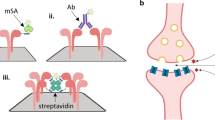Abstract
Compared are two approaches for the biotinylation of poly(N-isopropylacrylamide-co-vinylacetic acid) microgels, 300-nm diameter, water swollen particles with a corona of carboxyl groups. The biotinylated microgels are a platform for bioactive water-based ink. Streptavidin binding was measured as a function of biotin density, and the results were interpreted with a new model that predicts the minimum local density of biotins required to capture a streptavidin. An amino-polyethylene glycol derivative of biotin gave higher biotin contents than a biotin hydrazide. However, the streptavidin content versus biotin content results for both biotin derivatives fell on the same master curve with maximum biotin coverage of 0.11 mg of bound streptavidin per milligram of biotinylated microgel. Exclusion experiments showed that streptavidin was too big to penetrate the cross-linked microgel structure; thus, the conjugated streptavidin was restricted to the microgel surface. The colloidal stability of the microgels was preserved, and the biotinylated products showed good hydrolytic stability.




Similar content being viewed by others
References
Kawaguchi H, Fujimoto K, Mizuhara Y (1992) Hydrogel microspheres.3. Temperature-dependent adsorption of proteins on poly-N-isopropylacrylamide hydrogel microspheres. Colloid Polym Sci 270(1):53–57
Pichot C (2004) Surface-functionalized latexes for biotechnological applications. Curr Opin Colloid Interface Sci 9(3–4):213–221
Pelton RH, Chibante P (1986) Preparation of aqueous latices with N-isopropylacrylamide. Colloids Surf 20(3):247–256
Pelton R (2000) Temperature-sensitive aqueous microgels. Adv Colloid Interface Sci 85(1):1–33
Nayak S, Lyon LA (2005) Soft nanotechnology with soft nanoparticles. Angew Chem Int Ed 44(47):7686–7708
Oh JK, Drumright R, Siegwart DJ, Matyjaszewski K (2008) The development of microgels/nanogels for drug delivery applications. Prog Polym Sci 33(4):448–477. doi:10.1016/j.progpolymsci.2008.01.002
Hoare T, Pelton R (2008) Impact of microgel morphology on functionalized microgel–drug interactions. Langmuir 24(24):1005–1012
Das M, Zhang H, Kumacheva E (2006) Microgels: old materials with new applications. Annu Rev Mater Res 36:117–142
Kawaguchi H, Kisara K, Takahashi T, Achiha K, Yasui M, Fujimoto K (2000) Versatility of thermosensitive particles. Macromol Symp 151:591–598
Taniguchi T, Duracher D, Delair T, Elaissari A, Pichot C (2003) Adsorption/desorption behavior and covalent grafting of an antibody onto cationic amino-functionalized poly(styrene-N-isopropylacrylamide) core–shell latex particles. Colloids Surf B Biointerfaces 29(1):53–65
Colonne M, Chen Y, Wu K, Freiberg S, Giasson S, Zhu XX (2007) Binding of streptavidin with biotinylated thermosensitive nanospheres based on poly(N,N-diethylacrylamide-co-2-hydroxyethyl methacrylate). Bioconjug Chem 18(3):999–1003
Hong C-Y, Pan C-Y (2006) Direct synthesis of biotinylated stimuli-responsive polymer and diblock copolymer by raft polymerization using biotinylated trithiocarbonate as raft agent. Macromolecules 39(10):3517–3524. doi:10.1021/ma052593+
Sirpal S, Gattas-Asfura KM, Leblanc RM (2007) A photodimerization approach to crosslink and functionalize microgels. Colloids Surf B Biointerfaces 58(2):116–120
Su S, Ali MM, Filipe CDM, Li Y, Pelton R (2008) Microgel-based inks for paper-supported biosensing applications. Biomacromolecules 9(3):935–941
Pelton R (2009) Bioactive paper—a low cost platform for diagnostics. Trends Anal Chem 28(8):925–942
Hoare T, McLean D (2006) Kinetic prediction of functional group distributions in thermosensitive microgels. J Phys Chem B 110(41):20327–20336
Hoare T, Pelton R (2004) Functional group distributions in carboxylic acid containing poly(N-isopropylacrylamide) microgels. Langmuir 20(6):2123–2133
Debord JD, Lyon LA (2007) On the unusual stability of succinimidyl esters in pNIPAm-AAc microgels. Bioconjug Chem 18(2):601–604
Hermanson GT (1996) Bioconjugate techniques. Academic, San Diego
Prestwich G, Marecak D, Marecek J, Vercruysse K, Ziebell M (1998) Controlled chemical modification of hyaluronic acid: synthesis, applications, and biodegradation of hydrazide derivatives. J Control Release 53(1–3):93–103
Kremsky J, Wooters J, Dougherty J, Meyers R, Collins M, Brown E (1987) Immobilization of DNA via oligonucleotides containing an aldehyde or carboxylic acid group at the 5′ terminus. Nucleic Acids Res 15(7):2891
Yang M, Teeuwen RLM, Giesbers M, Baggerman J, Arafat A, de Wolf FA, van Hest JCM, Zuilhof H (2008) One-step photochemical attachment of NHS-terminated monolayers onto silicon surfaces and subsequent functionalization. Langmuir 24(15):7931–7938. doi:10.1021/la800462u
Nayak S, Lyon LA (2004) Ligand-functionalized core/shell microgels with permselective shells. Angew Chem Int Ed 43(48):6706–6709
Hoare T, Pelton R (2004) Highly pH and temperature responsive microgels functionalized with vinylacetic acid. Macromolecules 37(7):2544–2550
McCormick D, Roth J (1970) Specificity, stereochemistry, and mechanism of the color reaction between p-dimethylaminocinnamaldehyde and biotin analogs. Anal Biochem 34(1):226–236
Ahmed J, Verma K (1979) Determination of d-biotin at the microgram level. Talanta 26(11):1025
Hoare T, Pelton R (2006) Dimensionless plot analysis: a new way to analyze functionalized microgels. J Colloid Interface Sci 303(1):109–116
Nakajima N, Ikada Y (1995) Mechanism of amide formation by carbodiimide for bioconjugation in aqueous-media. Bioconjug Chem 6(1):123–130
Kurzban GP, Bayer EA, Wilchek M, Horowitz PM (1991) The quaternary structure of streptavidin in urea. J Biol Chem 266(22):14470–14477
Ren CL, Carvajal D, Shull KR, Szleifer I (2009) Streptavidin–biotin binding in the presence of a polymer spacer. A theoretical description. Langmuir 25(20):12283–12292. doi:10.1021/la901735d
Bogusiewicz A, Mock NI, Mock DM (2004) Instability of the biotin–protein bond in human plasma. Anal Biochem 327(2):156–161. doi:10.1016/j.ab.2004.01.011
Bogusiewcz A, Mock NI, Mock DM (2004) Release of biotin from biotinylated proteins occurs enzymatically and nonenzymatically in human plasma. Anal Biochem 331(2):260–266. doi:10.1016/j.ab.2004.05.020
Acknowledgments
Prof. Todd Hoare is thanked for useful discussions. The authors acknowledge the SENTINEL Bioactive Paper NSERC Network for financial support. RP and YL hold Canada Research Chairs.
Author information
Authors and Affiliations
Corresponding author
Rights and permissions
About this article
Cite this article
Xu, Y., Pharand, L., Wen, Q. et al. Controlling biotinylation of microgels and modeling streptavidin uptake. Colloid Polym Sci 289, 659–666 (2011). https://doi.org/10.1007/s00396-010-2305-8
Received:
Revised:
Accepted:
Published:
Issue Date:
DOI: https://doi.org/10.1007/s00396-010-2305-8




